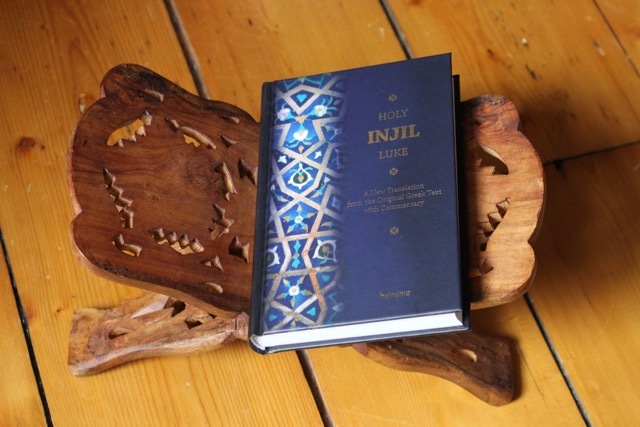Introduction
In the rich tapestry of Islamic theology, the Injil holds a unique and significant position. Derived from the Greek term euaggelion, which translates to “good news” or “gospel,” the Injil is mentioned twelve times in the Qur’an, yet its essence often remains clouded in ambiguity. This comprehensive exploration aims to unravel the layers of Islamic thought surrounding the Injil, its origins, and its implications for both historical and contemporary religious landscapes. At Umrah International, we believe in fostering understanding and respect among different faith traditions, including the intricate beliefs surrounding the Injil.
The Etymology of Injil
The term Injil finds its roots not only in Greek but also in the Ethiopian wangel. The Qur’an references it primarily in two surahs: Al-Maidah (5:46) and Al-Maidah (5:57), depicting it as a divine revelation given to Jesus (Isa – PBUH). Various historical sources suggest that the Injil was revealed during the sacred month of Ramadan, although discrepancies exist regarding the exact date.
Revelation Timeline
The timeline regarding the revelation of the Injil varies among Islamic scholars. Some assert it occurred on the thirteenth day of Ramadan, while others propose the eighteenth. This points to the larger narrative that the Injil was revealed approximately twelve hundred years after the Zabur (Psalms) was given to Dawood (PBUH). This period marks a significant evolution in the divine messages conveyed to humanity.
The Injil in the Qur’an
The Qur’an refers to the Injil as a sacred scripture that was accessible to the Christians contemporary to Muhammad (PBUH). In Surah Al-Maidah (5:47), the Qur’an notes that Christians were expected to adhere to the teachings of their scriptures, suggesting that the Injil was indeed recognized and respected within the Islamic framework.
The Status of the Injil
In various references, the Qur’an does not dismiss the legitimacy of the Injil possessed by Christians during Muhammad’s time. For example, in Surah An-Nisa (4:171), while criticizing certain theological errors, it does not claim that Christians lacked access to the authentic Injil. This nuanced understanding highlights the complex relationship between Islam and other Abrahamic faiths.
Islamic Commentators and the Injil
Noteworthy commentators, including Badawi and Zamakhshari, acknowledge that Injil is not an Arabic term but is borrowed from Syriac, a language used by early Christians to describe the Gospel. This admission is crucial as it underscores the cultural and linguistic exchanges that occurred during the early Islamic period.
Diverse Interpretations of the Injil
Historically, interpretations of what constituted the Injil have varied. Some Muslims viewed it as encompassing only the four Gospels, while others believed it referred to the entire New Testament. This lack of consensus often led to allegations that Christians had altered the original text of the Injil.
Historical Context of Christian Scriptures
The Arabic Translation of the Gospels
The earliest known translations of the Gospels into Arabic can be traced back to the 7th century. Waraqah ibn Naufal, who converted to Christianity, is reputed to have transcribed Gospels in Hebrew, revealing an early intersection between Islamic and Christian texts. According to al-Qastallani, the Injil was initially revealed in Syriac, subsequently translated into multiple languages, including Arabic.
Notable Translations
One significant translation effort occurred between 631 and 640 CE, commissioned by the Arab prince ’Amr b. Sa’d. This marks one of the earliest references to a known Arabic manuscript of the Gospels, emphasizing the importance of language in the transmission of religious texts.
Non-Canonical Texts and Their Influence
Alongside the canonical Gospels, various apocryphal texts emerged in Arabic, including the Protoevangelion of James and the Gospel of Thomas. These writings reflect the diverse beliefs and narratives circulating among early Christian communities in the region.
Oral Tradition and Christian Influence in Pre-Islamic Arabia
The Role of Christian Communities
Before the advent of Islam, Christian ideas permeated Arabian society, largely propagated through oral tradition. Organized Christian communities in regions like Yemen and north-east Arabia maintained a robust presence, sharing narratives from both canonical and apocryphal texts.
Key Influences
The Nestorian church played a crucial role in the spread of Christian teachings. Poets and storytellers, like Zaid b. ‘Amr b. Nufail, are believed to have interacted with these Christian communities, further intertwining Christian narratives with pre-Islamic Arabian culture.
Quranic References to the Injil
The Qur’an contains numerous passages that reflect knowledge of both canonical and apocryphal Christian texts. The narratives surrounding Jesus, Mary, and John the Baptist are prominent, emphasizing the divine aspects of their stories.
Notable Quranic Verses
For instance, Surah Al-Maidah (5:112-115) includes vivid descriptions of Jesus’ miracles and divine birth, echoing themes present in the Gospels. Similarly, parables found in the Gospels resonate within Quranic literature, such as the parable of the sower (Al-Fath 48:29).
Intertextuality Between the Qur’an and the Gospels
Miracles and Teachings
Several miracles attributed to Jesus in the Gospels find their counterparts in Islamic tradition. This intertextuality fosters a deeper understanding of how these narratives shaped the theological landscape of early Islam.
Example of the Labourers in the Vineyard
One striking example is the reformation of the parable of the laborers in the vineyard from Matthew 20:1-16. In Islamic retellings, it serves as a critique of the relationships between Muslims, Jews, and Christians, highlighting theological commonalities and differences.
Early Islamic Historiography and the Injil
Muslim Historians and the Gospels
Prominent historians such as al-Yaqubi and al-Masudi exhibited significant familiarity with the Gospels. Al-Masudi, for example, recounts tales of Jesus’ birth and childhood with an emphasis on the interplay between Christian and Islamic narratives.
Al-Biruni’s Insights
Al-Biruni’s works reflect an extensive engagement with various religions, including Christianity. His objective analysis of the Gospels, alongside his historical insights, illustrates a broader understanding of religious texts within the early Islamic intellectual milieu.
The Historic Reliability of the Gospel
The Nature of Gospel Transmission
The Injil, embodying the essence of Jesus’ teachings, serves as a “good news” proclaiming God’s love. By the mid-first century, the Gospels were documented, capturing the life and principles of Christ.
Accuracy of Preservation
The meticulous care in preserving these texts has been noted, with the Gospels being transcribed onto papyrus and parchment, ensuring their longevity and fidelity over time. This historical accuracy has become foundational for understanding early Christianity and its impact on Islamic thought.
The Interwoven Nature of the Injil (Gospel) in the Qur’an: A Divine Blueprint
Introduction
Upon my first reading of the Qur’an, the references to the Injil (the Gospel) captivated my attention not only because of their frequency but also due to the distinct manner in which they are presented. Each mention of the Injil is intricately linked to the Taurat (Law), forming a pattern that raises important questions about the relationship between these scriptures. This analysis aims to delve into this pattern, exploring its implications for understanding the connection between the Qur’an, the Injil, and the Taurat.
Key Verses Mentioning the Injil
The Qur’an articulates the significance of the Injil across several verses, often placing it alongside the Taurat. Here are the crucial verses that highlight this relationship:
- Surat 3:3-4 (Al-Imran)
“It is He Who sent down to you the Book in truth, confirming what came before it; and He sent down the Law and the Gospel before this, as a guide to mankind…”- This verse frames the Qur’an as a culmination of previous revelations, establishing a lineage of divine guidance.
- Surat 3:48 (Al-Imran)
“And Allah will teach him [Jesus] the Book and Wisdom, the Law and the Gospel…”- Here, the divine education imparted to Jesus emphasizes the continuity of revelation through divine instruction.
- Surat 3:65 (Al-Imran)
“You People of the Book! Why do you dispute about Abraham, when the Law and the Gospel were not revealed until after him?”- This verse underscores the chronological context of revelations, clarifying the order of divine guidance.
- Surat 5:46 (Maida)
“And in their footsteps We sent Jesus the son of Mary, confirming the Law that had come before him…”- This indicates that Jesus’ mission was not to create a new path but to affirm and expand upon existing teachings.
- Surat 5:66 (Maida)
“If only they [People of the Book] had stood fast by the Law, the Gospel, and all the revelations sent from their Lord.”- A call for adherence to all divine guidance, reinforcing the interdependence of these texts.
- Surat 5:68 (Maida)
“Oh people of the Book! You have no ground to stand upon unless you stand fast by the Law, the Gospel, and all the revelation that has come to you.”- This emphasizes the necessity of these revelations for spiritual grounding and moral guidance.
- Surat 5:110 (Maida)
“Behold I [Allah] taught you [Jesus] the Book and Wisdom, the Law and the Gospel…”- This reiterates the theme of divine education, reinforcing the interconnectedness of these texts.
- Surat 9:111 (Tauba)
“A promise binding on Him in Truth, through the Law, the Gospel, and the Qur’an.”- This verse intertwines the three texts as part of a divine covenant.
- Surat 48:29 (Fat-h)
“This is their similitude in the Taurat, and their similitude in the Gospel is like a seed that sends forth its blade…”- A metaphorical illustration of spiritual growth that connects the teachings of the Taurat and the Injil.
The Unique Relationship of the Law and the Gospel
One of the most striking aspects of these verses is that the term ‘Gospel’ is consistently presented alongside ‘the Law.’ Unlike other scriptures mentioned in the Qur’an, the Injil is always referenced in relation to the Taurat. This pattern is noteworthy as it sets the Injil apart, suggesting a unique dependence on the teachings found in the Taurat.
In contrast, the Qur’an can be referenced independently, as can the Taurat, which allows for a broader context in discussions of divine revelation. For instance:
- Surat 6:154-155 (Cattle) refers to the completeness of the Book given to Moses without mention of the Injil.
- Surat 4:82 (The Women) challenges the Qur’an’s authenticity by asserting its divine origin, independent of other texts.
The Exception: A Consistent Context
There exists one notable exception to this established pattern:
- Surat 57:26-27 (Hadid) states, “And we sent Noah and Abraham… we followed them with Messengers. We sent after them Jesus the son of Mary, and bestowed on him the Gospel…”
- Here, while the Injil is not directly preceded by ‘the Law,’ the context includes prophets whose narratives are foundational in the Taurat, thus maintaining the overarching pattern of continuity.
Significance of the Pattern
The question arises: Why is this pattern significant? While some may view it as a coincidence, I believe it serves as a profound sign from Allah. This connection implies that to truly understand the Injil, one must first engage with the Taurat. It suggests that the teachings and lessons of the Taurat serve as a foundational framework for comprehending the deeper truths found in the Injil.
The Qur’an posits that the prophets are signs for humanity, encouraging us to seek wisdom from their messages:
- Surah 7:35-36 (The Heights) states, “O you children of Adam! Whenever there come to you Messengers from amongst you, rehearsing My Signs…”
- This invitation to heed the signs of the prophets underscores the importance of understanding the foundational texts before moving to subsequent revelations.
The Journey Towards Understanding
As we seek to grasp the essence of the Injil, it may be beneficial to first explore the teachings of the Taurat. This journey could include:
- Investigating the narratives of early prophets, such as Adam, Noah, and Abraham, to uncover their teachings and implications.
- Analyzing the integrity of the Taurat, Zabur, and Injil, and addressing questions of their potential corruption as raised by the Qur’an.
- Utilizing textual criticism to deepen our understanding of these sacred texts and their interrelations.
The interconnected nature of the Taurat and the Injil within the Qur’an presents a rich opportunity for exploration and reflection. By recognizing the importance of the Taurat as a precursor to the Injil, we can enhance our understanding of both texts and their roles in the spiritual journey of believers. This pursuit of knowledge is not merely academic; it is a path towards spiritual enlightenment and alignment with the divine will. As we embark on this journey, let us seek to uncover the profound wisdom embedded within these sacred teachings, guiding us toward the Straight Way as articulated in Surah Al-Fatihah. Embracing this quest with curiosity and openness may lead us to greater truths and a deeper connection to the divine.
Understanding the Concept of Injil in the Qur’an: An In-Depth Analysis
Overview of the Injil’s Occurrence in the Qur’an
The term Injil, which refers to the revelation delivered to Jesus (Isa), appears twelve times in the Qur’an (3:2, 3:43, 3:58, 5:50, 5:51, 5:70, 5:72, 5:110, 7:156, 9:112, 48:29, 57:27). Notably, all occurrences are found in Medinan passages, except for 7:156/157, typically identified as a late Meccan reference. The term is distinctly used to describe the Christian revelation, primarily the Gospels, and often extends in contemporary usage to encompass the entire New Testament.
The Injil signifies not only the scripture known to Jesus’ contemporaries but also the broader spiritual message he preached. While the Qur’an does not delve deeply into the specific content of the Injil, it emphasizes the core principles of Jesus’ message—obedience to God and worship of the One True God—evident in verses like 3:79 and 43:63-64. In contrast, 5:116 poses a direct challenge to Jesus regarding the worship of himself and his mother, to which he firmly responds that he has no right to make such claims.
Furthermore, in 61:6, Jesus foretells the arrival of a figure referred to as Ahmed, whom Muslims associate with Muhammad. This perspective indicates that the essence of Jesus’ teachings exists within the Injil, thereby diminishing the need for the Qur’an to reiterate those lessons, as Parrinder suggests, “The teachings of Jesus are in the Gospel, and the Qur’an does not repeat them.” Crucially, the Qur’an makes it clear that Jesus did not promote the concept of the Trinity or claim divinity.
The Islamic Perspective on Scripture
In Islam, God, characterized as infinitely merciful, continuously sends prophets to guide humanity along the straight path (Sirat al-Mustaqim) and to clarify the distinctions between what is permissible (halal) and prohibited (haram). Following Adam’s transgression, God forgave him and imparted “words of inspiration” (Q2:37), which is believed to refer to the first scripture or Kitab.
Throughout history, prophets, including Moses, received specific Books as divine guidance. The Injil is identified as the Book revealed to Jesus, affirming and confirming earlier revelations, particularly the Taurat (Law). For instance, 5:46 indicates that the Injil confirms the Torah. The Qur’an itself, as the final revelation, is said to validate previous scriptures, specifically noting “the Law of Moses and the Gospel of Jesus” (3:3). This necessity for fresh revelations arises from humanity’s rejection and subsequent distortion of earlier scriptures.
Distinction Between Injil and the Gospels
Muslim scholars generally debate the relationship between the Injil and the Gospels. While some posit that the Injil refers to the entire New Testament, others argue it encompasses only the core teachings of Jesus rather than a specific written text. The term Injil appears in the Qur’an, Hadith, and early Islamic literature specifically to denote the revelations given to Jesus, and it is still used by both Muslims and some Arabic-speaking Christians today.
Questions of Accuracy and Authority
Concerns regarding the authenticity of the Injil often lead to discussions of tahrif, or the distortion of texts. Some Muslim scholars assert that the Injil has undergone changes, including suppression and additions. This idea is rooted in Qur’anic verses such as 3:78, which criticizes certain “people of the Book” for misrepresenting their scriptures, and 3:71, which accuses them of mingling truth with falsehood.
Disputed passages within the Injil often revolve around references to Jesus as the Son of God and the events following his death. Many Muslims reject the notion of Jesus’ crucifixion and resurrection, instead believing he was raised to heaven without experiencing death, as suggested in Q4:171. Contrastingly, 19:33 indicates Jesus acknowledged a day of death and resurrection. The eschatological role of Jesus is further explored in verses like 3:55 and 4:159, where he is mentioned in the context of the Day of Judgment.
The Charge of Tahrif in Muslim-Christian Dialogue
The concept of tahrif often arises in discussions between Muslims and Christians, with some Islamic thinkers dismissing the entirety of the Bible as corrupted. Figures like Ibn Hazm argued that contradictions within Christian scriptures demonstrate their unreliability, while Ibn Taymiyyah contended that the Gospels resemble Hadith more than divine scripture, since they consist of accounts about Jesus rather than direct revelations from God.
In contrast, others like Syed Ahmed Khan proposed that while the Gospels may not equate with the Injil, they contain authentic elements reflective of Jesus’ original message. He cautioned against assuming that all interpretations signify a physical alteration of the text.
The Qur’an’s Unique Position
Many Muslims maintain that among the revealed books, only the Qur’an remains free from tahrif, asserting its flawless nature as opposed to earlier scriptures like the Taurat, Zabur, and Injil. The Qur’an is regarded as the only text devoid of doubt (Q2:2). Esack articulates this sentiment, stating that while belief in the divine origin of all previous scriptures is essential for Muslims, in practice, they consider the Qur’an as the sole valid scripture and the only pathway to salvation.
The Gospel of Barnabas has gained traction among some Muslim authors as a candidate for the true Injil, a notion reflecting the broader skepticism toward the canonical Gospels. Yet, figures like Hasan Askari, a notable scholar engaged in Christian-Muslim dialogue, did not dismiss the Gospels outright and expressed a genuine appreciation for their narratives.
The interplay between the Qur’an, Injil, and the Gospels invites profound theological reflection. While the Qur’an acknowledges the significance of earlier revelations, it asserts its finality and completeness as the definitive guide for humanity. Understanding the nuances of the Injil’s representation in Islamic thought is crucial for fostering dialogue and bridging gaps between different faith perspectives. As scholars continue to explore these complexities, a more nuanced appreciation of the role of scripture in both Islam and Christianity can emerge, promoting mutual understanding and respect.
Conclusion: Bridging Faiths with Understanding
The Injil represents a vital link between Islamic and Christian traditions, fostering a dialogue that transcends historical conflicts. At Umrah International, we are committed to promoting a deeper understanding of such intersections in faith, enhancing the spiritual journeys of our community.
As we conclude this extensive exploration of the Injil within Islamic thought, we invite our readers to reflect on the shared values and teachings present in both faiths. Understanding these connections enriches our spiritual journeys and fosters a more inclusive environment for dialogue and discovery.

















